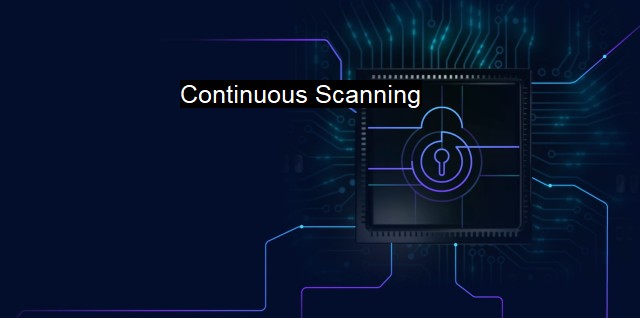What is Continuous Scanning?
Why Companies Must Implement Continuous Scanning for Comprehensive Cybersecurity: Identifying and Remedying Security Threats and Vulnerabilities through Automated Tools and Processes
Continuous scanning is a crucial method employed in cybersecurity to protect the integrity of a network and its data. As the name suggests, it deploys a continuous engine which scans, detects, and prevents potential cyber threats recurrently. The effectiveness of cybersecurity rests on this notion of persistence; the idea that it doesn't merely react to attacks, but constantly guards against them.Continuous scanning is intrinsively connected to vulnerability management as it continuously reviews systems to unearth potential threats and mitigate any risk. It bypasses the traditional lifecycle of a point-in-time evaluation style which often leaves networks vulnerable to new, fast-emerging threats. With evolutionary exists adapted cyber attackers, which necessitates security mechanisms to become more insightful and almost predictive in their response. This constant evaluation and adaptation are what denotes the concept of continuous scanning.
Primarily, continuous scanning serves to protect systems from various forms of cyber threats, these include viruses, malware, spyware, ransomware, and phishing attacks, among others. By persistently scanning every bit of data that flows within and into a network, it ensures a robust defensive bulwark.
Large preexisting security loopholes can be agilely identified and remedied through continuous scanning. it’s the hidden, overlooked vulnerabilities that continuous scanning truly excels in detecting. These vulnerabilities often serve as the easiest points of entry for attackers, and their discovery and mitigation drastically reduce the susceptibility of systems to malicious attacks.
Consequently, the success of continuous scanning can placify organizations operating in both public and private sectors with varying degree of sensitivity and confidentiality about their data security. This confidence comes from the method’s capability to deter external penetration and internal mishandling of sensitive information which could disrupt the ongoing work patter or impact reputation.
An elaborate mechanism is behind this operation. For instance, antivirus software commonly employs continuous scanning. It continually monitors a system’s files, examining them for known patterns that match the definitions of known viruses or new unusual activity. In the event of a match, the software alerts the user about the potential threat and may automatically take action such as quarantining the suspect file. Effectively, this technique blocks installed malware even before being activated or spreading across the network.
Continuous scanning ensures compliance with a list of cybersecurity frameworks and standards. To maintain good reputations and avert penalties, businesses need to adhere to specific guidelines based on their industry or country. the regulation for protection of personally identifiable information (PII) under the General Data Protection Rule (GDPR) in Europe or the Health Insurance Portability and Accountability Act (HIPAA) in the U.S. mandate specific technical safeguards, which can be implemented via continuous scanning protocols.
It's crucial to remember that continuous scanning doesn't always peer into a solid layer of defense. Naturality of software bugs, undiscovered vulnerabilities, and user practices variation may lead to inevitable breaches. Attaining an optimal balance demands a multi-layered method combining continuous scanning, supplemental security protocol, and curated user practices.
In an era dominated by digital infrastructures, continuous scanning is a requisite for ensuring cybersecurity. It may not be a fool-proof solution in fending off cyber threats, but it is an indubitably powerful tool that forms the backbone of a multi-layered cybersecurity strategy. It provides not only protection but a crucial edge in a digital world where a sophisticated cyber-attack may be just a heartbeat away. Lastly, it is an evolving art ranging from scanning for threats to analyzing threat patterns and behavior, predictive prevention to responsive mitigation. It is on an ascending trajectory of growth promising a future of cybersecurity that is proactive and not just reactive.

Continuous Scanning FAQs
What is continuous scanning in cybersecurity?
Continuous scanning is a process of regularly scanning the network or system for potential cybersecurity threats and vulnerabilities. This approach helps to ensure that the system is constantly monitored and protected against potential attacks.How does continuous scanning differ from traditional antivirus?
Traditional antivirus software only scans the system at the time of installation or when a scheduled scan is initiated. Continuous scanning, on the other hand, regularly monitors the system in real-time to catch any potential threats as soon as they appear.What are the benefits of continuous scanning?
Continuous scanning helps to identify potential security risks before they can cause harm to the system. It also helps to ensure that the system is always up-to-date with the latest security patches and updates. In addition, continuous scanning helps organizations meet compliance requirements related to cybersecurity.Is continuous scanning suitable for all types of organizations?
Yes, continuous scanning is beneficial for organizations of all sizes and types. It is particularly useful for businesses that handle sensitive data or operate in industries with strict regulatory requirements. By continuously monitoring the network, organizations can identify and address potential threats in a timely manner.| | A | | | B | | | C | | | D | | | E | | | F | | | G | | | H | | | I | | | J | | | K | | | L | | | M | |
| | N | | | O | | | P | | | Q | | | R | | | S | | | T | | | U | | | V | | | W | | | X | | | Y | | | Z | |
| | 1 | | | 2 | | | 3 | | | 4 | | | 7 | | | 8 | | |||||||